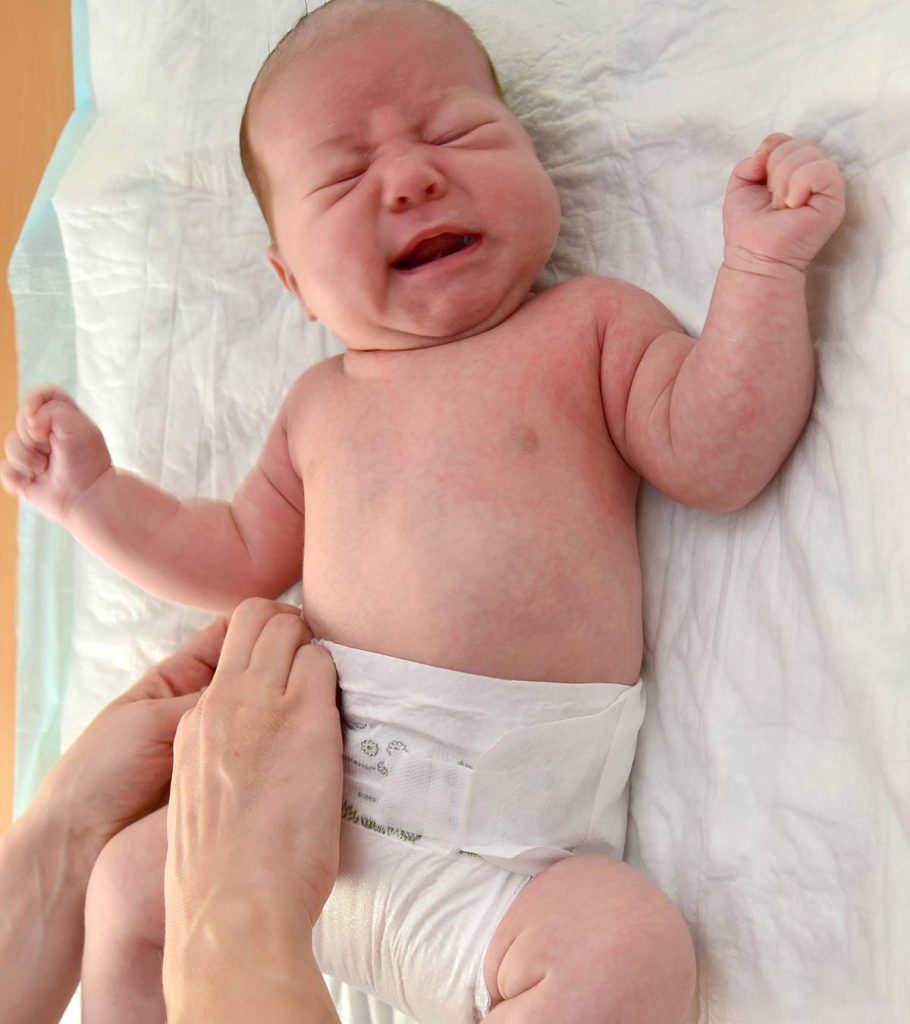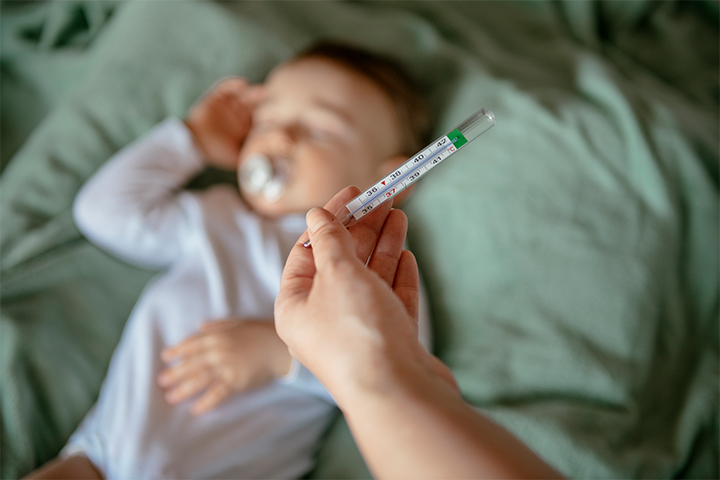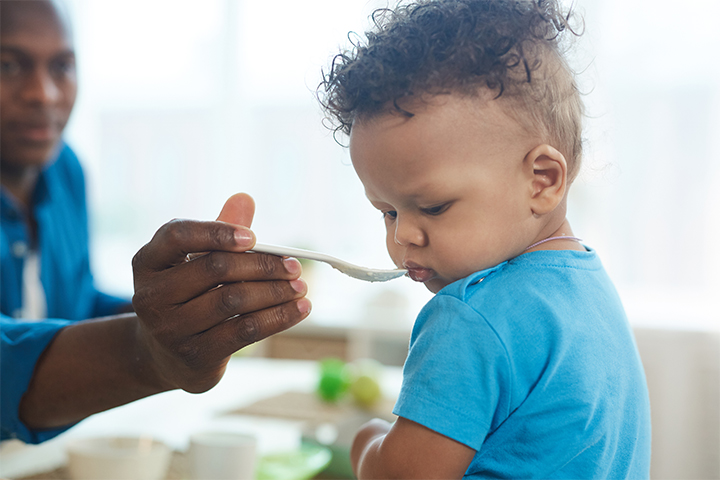The signs of urinary tract infection in babies can be hard to identify as the symptoms mainly include frequent urination and wetting, among others, which are common problems in any baby. However, if you notice your child experiencing pain while passing urine or signs of fever, consult your doctor immediately as it might indicate a urinary tract infection. Read on to know more about the causes, symptoms, diagnosis, treatment, and prevention of UTI in babies.
What Are UTIs?
A urinary tract infection is a bacterial infection of the urinary tract that affects the bladder, and in some cases the kidneys too causing pyelonephritis or kidney infection. A child contracts a UTI when pathogens invade parts of the urinary tract – from the kidney to the urethra. This can involve the upper or lower part of the urinary tract such as Urethritis. Most UTIs are caused by bacteria and rarely by a virus or fungus (1).
How Does A Baby Get UTI?
Bacteria are typically found in the environment and on the skin around the urethra. When the bacteria enter the urethra, they result in a urinary tract infection. The risk of the UTI in babies is high in the following scenarios (2):
- Poor toilet hygiene: It is essential to properly clean the baby’s groin when you Always wipe from the front to the back to prevent the transfer of bacteria from the stool to the urethra. Improper cleaning during a diaper change and keeping the diaper soiled for too long increases the risk of a baby getting a UTI.
- Gender: Girls are more prone to getting a UTI than boys. The reason is the proximity of the urethra to the anus. Girls also have a shorter urethra which means the bacteria have a shorter distance to travel to infect the bladder.
- If an older child holds urine for a long time, she is more likely to develop stagnation and later UTI.
- Certain medical conditions: Some medical conditions such as vesicoureteral reflux or an overactive bladder can exacerbate the chances of the baby getting a UTI. Vesicoureteral reflux is a condition where the urine flows backward into the kidneys from the bladder through the ureters, causing hydronephrosis in infants. Overactive bladder is when the bladder is unable to hold urine for long and involuntarily leaks it through the urethra.
- Congenital disorders: Anomalies in the structure and physiology of the urinary tract can make the baby susceptible to the development of UTIs. An example is ureteroceles where the ureter swells at the point of attachment to the bladder 3.
- A family history of UTIs: If you have a family history of UTIs, then the baby can be susceptible to the condition too.
What Pathogens Cause UTIs In Babies?
The leading cause of UTIs in babies is Escherichia coli or the E. coli bacteria. It accounts for more than 80% of total UTI incidents (4). E. coli is commonly found in the human gut and can quickly spread to the urinary tract (5).
Other bacteria that cause UTI are from the genus Klebsiella, Enterobacter, Citrobacter, Serratia, and Staphylococcus (6). Several of these bacteria transmit through contaminated catheters that are connected to the urethra of bed-ridden patients at hospitals.
How Common Is UTI In Babies?
According to the American Urological Association, pediatric UTI accounts for about 1.5 million visits to health care providers in the US each year. The risk of UTI is 7% for girls and 2% for boys. However, experts state that more boys seem to get a UTI than girls during the first year of life, with the risk being more in case of uncircumcised boys (7).
What Are The Symptoms Of UTI In Babies?
UTI can be hard to spot among infants since it mimics the symptoms of other diseases. Seek medical attention if you notice the following signs of UTI in toddlers and babies (8):
- Fever with no cough, cold, or other flu symptoms.
- Colic and fussiness due to constant lower abdominal pain. The baby may squeal in pain when lightly pressed at the lower abdomen or around the bladder.
- Some babies may have pain even in the lower back.
- Pain or burning sensation during urination.
- Unusual urine odor, which you can notice during a diaper change.
- Cloudy urine.
- Vomiting and poor appetite.
- Increased frequency of urination due to inflammation of the bladder, which prevents the child from emptying it entirely.
- Older toddlers may avoid going to the toilet due to the pain associated with urination. It may make them hold feces too, which can lead to constipation.
- Development of daytime incontinence or bed wetting during the day. It is quite likely to happen when the child holds back the urine for very long and eventually loses control. It is noticeable among toddlers who are already potty trained.
Should you see any of the symptoms in the child, take them to the doctor right away.
Abby and Mike, a couple, share the symptoms his son Luke manifested before he was diagnosed with UTI. Abby says, “Luke was just crying and my husband said to try the telehealth thing. We consulted a doctor on the video chat and told him that our son was having a fever and was being fussy. The doctor didn’t say much and told us to consult a doctor in the morning… In the morning, we went to the urgent care because he was so fussy that he just cried, cried, and cried.
“We weren’t sleeping or even sitting down while holding him; I mean, it was just awful. The doctor checked his temperature and said it was 102.5, which is the highest it got till now… Afterward, the doctor said that it is usually a fever in babies when it comes to UTIs, and we stop testing boys for it when they turn two months… So, the doctor said that he would look it up and ask for a test if needed… After we returned from the
appointment, my husband and I got a call from the nurse who said we needed to get back and get the test done. The doctor says anything under one year of age needs to be tested if we suspect it to be UTI… They get a teeny tiny amount and they test him and sure enough, he has UTI (i).”
When to take the baby to a doctor?
Make no delay in your doctor’s visit when the little one displays the following symptoms (9):
- Baby is unable to pass urine at all
- Blood in the urine (Hematuria)
- Swelling of the abdomen, bladder, or at the urethra
- Fever above 100.4 °F (38 °C)
Further diagnosis may be required to determine the ideal course of treatment.
How Is UTI Diagnosed In Babies?
The following tests are used to diagnose a urinary tract infection (10):
- Urinalysis: Usually, there is little to no bacteria in the urine. But in the case of UTIs, the urine would be teeming with such pathogens. In urine analysis, a urine sample is collected in a container and checked for bacterial presence (bacteriuria).
- Urine culture: If the doctor suspects UTI, it is sent for a urine culture. A catheter is inserted into the urethra to collect uncontaminated urine straight from the bladder. It is ideal for young infants who are not potty trained and cannot urinate on demand. However, catheterization can be uncomfortable and even painful, and catheters pose a risk of causing UTIs. An alternative is to let the baby go without a diaper and collect a sample when they urinate with a clean catch midstream sample after cleaning the surrounding area.
- Ultrasound: If the urinalysis and urine culture confirm the presence of UTI, the doctor will suggest a renal ultrasound of the kidney and bladder. This checks for the presence of anomalies in the urinary tract that could have led to the problem.
- X-rays: X-rays are used to check for the presence of the vesicoureteral reflux, the condition where the urine flows back into the kidneys. A small amount of dye is introduced into the bladder through a urinary catheter. Doctors then track the flow of dye through X-rays to see if it flows upwards, towards the kidneys.
A combination of these diagnostic procedures helps pinpoint the fundamental cause of the urinary tract infection.
How Is UTI In Babies Treated?
The treatment depends on the cause of UTI. Treatment options include:
- Antibiotics: Since most UTIs are bacterial, an antibiotic treatment for one to two weeks is recommended for babies with an infection. Commonly prescribed antibiotics for bacterial UTIs include amoxicillin, co-trimoxazole, cefixime, and cefprozil. This would be based on the urine culture results. Sometimes if the baby is sick or there is upper UTI, she may require injectable antibiotics. Intravenous (IV) antibiotics used against UTIs are ampicillin, gentamicin, ceftriaxone, and cefotaxime (6) (7).
- Analgesic medication: These medicines help control pain and fever in infants. Examples are acetaminophen and ibuprofen. The doctor can prescribe these medicines to ease the discomfort associated with a urinary tract infection.
- Surgery: If an underlying congenital problem or a physical anomaly is the reason behind UTI, surgery may be necessary to rectify the problem. The baby will stay under observation until he or she is cured.
A baby should start feeling better within a few days after the treatment begins. Finishing the entire course of antibiotics is essential for a complete cure. Surgical treatment measures may require additional post-surgery care as advised by the doctor.
How To Care For A Baby With UTI?
Adequate home care can help the baby get better faster.
- Let them have adequate rest: Since the baby would have abdominal cramps, vigorous play and activities will make the infection worse. Rest is essential to expedite recovery.
- Older infants can have extra water: Giving extra fluids can help flush out bacteria from the urinary tract. If your baby is older than six months, then you can give them frequent sips of water.
- Increase the number of breastfeeds: If the baby is less than six months old, then increase the number of breastfeeds so that the baby gets enough fluids.
- Some foods are helpful: Some foods or nutrients can help reduce the bacteria in the urinary tract. Examples are fruits like cranberries and blueberries that are considered to cut down the population of bacteria. However, there is limited scientific evidence that states that these juices can mitigate UTIs in babies (11). Avoiding certain foods such as chocolate, caffeinated drinks, colas, and some spices can help prevent bladder irritation in toddlers (15).
- Vitamin C: Nutrients like vitamin C also help in reducing the bacteria. Since babies can have citrus fruits only after the age of 12 months, you can give other fruits, breast milk, and supplements to provide this nutrient to the baby (12).
Are There Complications Of Untreated UTI In Babies?
Yes. If a UTI is not treated in time, the bacteria can pass into the kidneys and cause complications in kidney functions. Another problem is sepsis, a condition where the pathogen enters the bloodstream and reaches different parts of the body causing multiple organ failures, which can be serious.
How To Prevent UTI In Babies?
Preventing UTIs in babies is simpler than it seems. Here are the steps you must observe to avoid a urinary tract infection:
- Clean properly before diaper change: Clean the baby’s diaper area with an antiseptic wipe, or with gentle soap and warm water, during a diaper change. It prevents the transfer of pathogens from the anus to the urethra thus minimizing the risk of UTI.
- Give the baby adequate fluids: Urination is the body’s natural method of flushing out pathogens in the urethra before they reach the bladder. Toddlers need about 1.3 liters of water intake in a day (13). Increasing the child’s water intake when they have a UTI can help rid the bacteria naturally before it develops into an infection.
- Teach not to hold urine for long: While some babies will urinate anytime and anywhere, older toddlers tend to hold urine for longer than required. Teach the toddler to not hold urine for long and go to the toilet anytime they have an urge to urinate, to prevent harboring bacteria inside the body.
- Breast milk protects against UTI.
Next, we answer a few commonly asked questions about UTIs in babies.
Fever and signs of pain while passing foul-smelling or cloudy urine may indicate urinary tract infection in babies. However, seek medical care and urinalysis if the symptoms are not obvious. Poor hygiene, female gender, and certain medical conditions increase the risk of contracting bacterial urinary tract infections. Further, babies with urinary system functional or structural anomalies are more vulnerable to UTIs than others. Pain relievers and antibiotics are often prescribed to treat urinary infections in babies. However, surgical correction of malformations is recommended in a few cases.
Acquire essential knowledge on preventing urinary tract infections in babies and kids. Benefit from expert advice and practical tips to safeguard your little ones’ health.
Key Pointers
- Bacterial infections affect the urinary tract, bladder, and kidneys causing urinary tract infections (UTIs).
- Certain medical conditions, poor hygiene, or a history of UTIs can make infants susceptible to UTIs.
- The symptoms of UTIs in infants include fever, colic, pain, foul-smelling and cloudy urine, vomiting, and frequent urination.
- Antibiotics, analgesics, and surgery are potential treatments for UTIs in infants.
- Preventing UTIs in infants involves maintaining good hygiene, changing diapers regularly, and promptly addressing any UTI symptoms.















